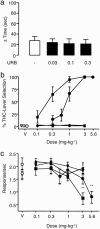Antidepressant-like activity and modulation of brain monoaminergic transmission by blockade of anandamide hydrolysis
- PMID: 16352709
- PMCID: PMC1317988
- DOI: 10.1073/pnas.0509591102
Antidepressant-like activity and modulation of brain monoaminergic transmission by blockade of anandamide hydrolysis
Erratum in
- Proc Natl Acad Sci U S A. 2006 Feb 14;103(7):2465
Abstract
Although anecdotal reports suggest that cannabis may be used to alleviate symptoms of depression, the psychotropic effects and abuse liability of this drug prevent its therapeutic application. The active constituent of cannabis, delta9-tetrahydrocannabinol, acts by binding to brain CB1 cannabinoid receptors, but an alternative approach might be to develop agents that amplify the actions of endogenous cannabinoids by blocking their deactivation. Here, we show that URB597, a selective inhibitor of the enzyme fatty-acid amide hydrolase, which catalyzes the intracellular hydrolysis of the endocannabinoid anandamide, exerts potent antidepressant-like effects in the mouse tail-suspension test and the rat forced-swim test. Moreover, URB597 increases firing activity of serotonergic neurons in the dorsal raphe nucleus and noradrenergic neurons in the nucleus locus ceruleus. These actions are prevented by the CB1 antagonist rimonabant, are accompanied by increased brain anandamide levels, and are maintained upon repeated URB597 administration. Unlike direct CB1 agonists, URB597 does not exert rewarding effects in the conditioned place preference test or produce generalization to the discriminative effects of delta9-tetrahydrocannabinol in rats. The findings support a role for anandamide in mood regulation and point to fatty-acid amide hydrolase as a previously uncharacterized target for antidepressant drugs.
Figures





References
-
- (1994) Diagnostic and Statistical Manual of Mental Disorders: DSM-IV (Am. Psychiatr. Assoc., Washington, DC).
-
- Huestis, M. A., Gorelick, D. A., Heishman, S. J., Preston, K. L., Nelson, R. A., Moolchan, E. T. & Frank, R. A. (2001) Arch. Gen. Psychiatry 58, 322-328. - PubMed
-
- Volkow, N. D., Gillespie, H., Mullani, N., Tancredi, L., Grant, C., Valentine, A. & Hollister, L. (1996) Psychiatry Res. 67, 29-38. - PubMed
-
- O'Leary, D. S., Block, R. I., Turner, B. M., Koeppel, J., Magnotta, V. A., Ponto, L. B., Watkins, G. L., Hichwa, R. D. & Andreasen, N. C. (2003) NeuroReport 14, 1145-1151. - PubMed
-
- Nestler, E. J., Barrot, M., DiLeone, R. J., Eisch, A. J., Gold, S. J. & Monteggia, L. M. (2002) Neuron 34, 13-25. - PubMed
Publication types
MeSH terms
Substances
Grants and funding
LinkOut - more resources
Full Text Sources
Other Literature Sources
Chemical Information
Medical

